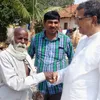This network of NGOs is eliminating human trafficking and slavery in Bihar and UP
Founded in 2012, Human Liberty Network undertakes activities to eliminate slavery and trafficking. It is also training government officials, supporting district level administration, helping spread awareness among communities, and advocating policy changes.
Sukhu Vanvaasi, a resident of Raipur Patti village in the Azamgarh district of Uttar Pradesh, would start his day by picking up clay and mixing other raw materials with his bare hands to make bricks. He would then squat barefoot amidst mounds of coal to heat the furnace for the production of bricks. His family was accustomed to looking at his carbon-spattered face and sore hands every day.
Not only was Sukhu made to work for more than 12 hours a day, but was also subject to social and economic abuse. Lack of regular income had forced him to turn towards bonded labour. Just when he was caught in the depths of despair, Human Liberty Network (HLN) approached Sukhu and helped him find a better source of livelihood.

The foundation for Human Liberty Network was laid in 2012 by a group of 16 non-governmental and community-based organisations to decrease the incidents of slavery and human trafficking, particularly in Bihar and Uttar Pradesh. Established as an extension of the Indo Nepal Human Liberty Network, these organisations are working to identify and rehabilitate individuals trapped in bonded labour and exploitation.
Sukhu says: “The representatives of Human Liberty Network made me aware of my rights. They gave me a trolley to sell products door-to-door so that I could earn on my own and take care of my family too.”
According to The Global Slavery Index (GSI) of 2016, nearly 18 million people in India are suffering under the crutches of slavery. Even the National Crime Records Bureau reported 35,503 cases of trafficking between 2011 and 2019.

Bonded labourers working at a stone quarry (representational image).
Image credits: International Justice Mission
At present, the HLN has been involved in a slew of activities to eliminate such instances of exploitation - from training police personnel and government officials, supporting district level administration, and helping spread awareness on ground to advocating policy changes.
“Forced labour, debt bondage, and other forms of abuse are very much prevalent on a large scale in the country. Poverty, unemployment, high debts, over-dependence on farming, and ignorance are some of the underlying reasons that drive it," Dr Bhanuja Sharan Lal, Executive Director, Manav Sansadhan Evam Mahila Vikas Sansthan (MSEMVS), tells SocialStory.
"With several daily wage earners and migrant workers losing their jobs after the COVID-19 outbreak, the stakes are even higher now,” he adds.
An endeavour to combat slavery and trafficking
The Human Liberty Network constitutes of organisations such as Aangan Trust, Centre DIRECT, MSEMVS, Prayas Juvenile Aid Centre, Tatvasi Sama Nyas, Nirdesh, Chetna, and many more.
One of the first initiatives HLN undertook was drafting a state action plan to combat human trafficking. Being one of the most populated regions of India, Uttar Pradesh consists of citizens from distinct social and cultural backgrounds. It is also known to have a high occurrence of child trafficking. Hence, the need for setting protocols was imperative.
After doing extensive research, all the partner organisations together came up with a set of measures for the government, judiciary, civil society, and NGOs.

A monthly meeting being held by the organisations part of Human Liberty Network.
“We laid down all the steps to be taken right from prevention of human trafficking to liberation, rehabilitation, and prosecution,” says Pramod Kumar Sharma, General Secretary, Centre DIRECT, Bihar.
The implementation framework involved monitoring trafficking routes, creating and maintaining a database on missing persons as well as migration at the village level, and identifying vulnerable groups for initiating prevention programmes.
In addition to this, the draft called for organising community drives to sensitise individuals, building capacities of vigilance agencies, setting up government helplines, offering the necessary financial assistance, counselling, care to the victims, and apprehending the exploiters.

Samir Kumar Digal (left) and Pramod Kumar Sharma.
“While the Department of Women and Child Development took on the baton to root out human trafficking, several other departments like labour, social welfare, health, and education were engaged in the process. For the purpose of coordinating the efforts of stakeholders, we suggested the appointment of a “Child Protection Officer” at the district level,” adds Sharma.
The Human Liberty Network also worked on a similar action plan for the District Magistrates of various districts in Bihar and UP to eliminate child labour. The model was formed in accordance with the Child and Adolescent Labour (Regulation and Prohibition) Act of 1986 as amended in 2016, as well as the Bonded Labour System (Abolition) Act of 1976.
The model mandates the gram sabha to take measures to make villages child labour free. It also recommends to organise street plays and workshops to raise awareness about child labour. Since one of the early signs of child labour is children dropping out of school, it advices School Management Committees to conduct a rapid survey and keep a tab on the dropout rate.

A counselling session in progress for survivors by HLN.
In order to promote discussion and dialogue about child labour, HLN organised a meeting in 2017 to highlight the gaps for the effective implementation of Integrated Child Protection scheme in Uttar Pradesh. Several government officers from the Ministry of Women and Child Development, the National Institute of Public Cooperation and Child Development (NIPCCD), Child Protection Unit, and Legal Service Authority of the state are known to have actively participated in it.
“Training stakeholders, police personnel, and the relevant government bodies is of utmost significance to prevent and identify instances of human trafficking. Hence, HLN made it its mission to set up training workshops,” says Samir Kumar Digal, Project Manager, Human Liberty Network.
“So far, the District level Vigilance Committee of Azamgarh and Allahabad, 268 police and investigating officers from 75 districts of Uttar Pradesh have been trained to identify, probe and handle instances of exploitation,” he added.
Recognising the power of social media, HLN also started leveraging various platforms to talk about bonded labour using the hashtag #BondMeNot. The campaign received a huge response from thousands of citizens across India. Many posters, slogans, editorials, and documentary films were invited to be a part of the campaign.
Taking one step at a time
All the 16 organisations part of Human Liberty Network meet on a monthly basis to coordinate and monitor training sessions as well as awareness events. The funds for most of these initiatives are pooled in from all the donors of the NGOs themselves.

A community awareness workshop being conducted by Human Liberty Network.
When asked about some of the hurdles encountered along the journey, Samir noted,
“The government officials we work with tend to keep getting transferred. Hence, many a times, we have had to start our effort and training from scratch. Besides, the entire task of coordinating and integrating the endeavours of multiple stakeholders to obtain the desired impact was in itself tedious and time-consuming. We have learnt that persistence is key,” quips Samir.
Since its inception, HLN has ensured the implementation of its action plan in over 650 villages across Uttar Pradesh and Bihar.
“A lot of women and children live in the dark shadows of human trafficking in India. Mostly trapped by force, coercion, or deception, they are gripped with angst and suffering. Since the exploitation happens underground, it is extremely tough to arrive at the numbers of victims," says Bhanuja.
"However, HLN has enabled the government to rescue and rehabilitate around 8,000 bonded labourers and trafficked individuals in the last few years”.

Image credit: Shutterstock.
With the closure of many business enterprises during the coronavirus pandemic, a large percentage of the migrant population have lost their jobs. This has made them vulnerable to human trafficking and forced labour.
HLN said it is planning to address this in the coming days by roping people into the Mahatma Gandhi National Rural Employment Guarantee Act (MNREGA).
Edited by Megha Reddy








